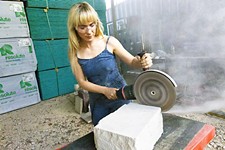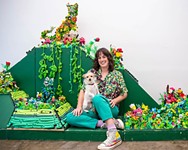"Premember" Drawings Capture Austin Shops Before They're Gone
Northern-Southern gallery is showing Drew Liverman's art series focused on quirky local businesses that are still here, but maybe not for long
By Barbara Purcell, Fri., Nov. 20, 2020
Drew Liverman is drawing attention to a disappearing Austin by drawing Austin before it disappears. His current series, "Premember," now on view through the Northern-Southern gallery website, is a weekly installment of an ever-changing city.
"He's going to places that are still here, to drink them in," says Northern-Southern's owner Phillip Niemeyer. "Like the way you look at your grandmother or someone you love when you know the time limit is there."
Liverman's drawings pack a pictorial punch. Their small scale, sheet-sized density, and immediacy can feel more like the product of a one-hour photo than crayon and marker.
Estrada's emits a honed casualness with its depiction of an East Seventh Street dry-cleaning business that's been family-owned and -operated since 1960. A deli-mustard yellow facade and Moorish arches seem more akin to Alhambra than East Austin. It's an old-school building with presence, and Liverman's rendering in the present builds on the not-too-distant past. Drew tells me he is drawn to the aesthetics of imperfection and impermanence. The Japanese call it "wabi-sabi" – no, not the latest sushi bar to open on East Sixth, but a universal notion found in the work of many artists Liverman admires, from the French post-impressionist Jean-Édouard Vuillard to the African American quiltmaker Rosie Lee Tompkins.
Liverman and I had a chance to talk about these influences, as well as loosely literally translating city still lifes still in this city's life.
Austin Chronicle: How did you come up with the idea behind this series?
Drew Liverman: A lot of businesses were struggling before COVID, and now it's even harder for them. The places I've been cataloging have taken on a more human, vulnerable quality. Before it was just like, "There's the carpet shop" or "the weird used car place," but then they came alive in the repetition of my quick commute. I live and work on the Eastside.
AC: Why these particular businesses?
DL: I actually haven't been inside a lot of these places. I don't know the owners. It's more like a stranger you pass on the street that you see all the time. The appeal is their autonomy – they each have their own quirky personal thing going on, which you don't see in new construction. A lot of the trendy mixed-use spaces, like on East Sixth, are so monolithic in their design.
– Drew Liverman
AC: Did you approach Northern-Southern or vice versa?
DL: Phillip proposed the idea. A lot of his shows have been focusing on the East Austin community, so it was a good fit. He's been amazing about doing all of these projects during this time. I had actually already started the series. I was tired of drawing the inside of my house and my family. I needed to turn to the outside world. There are less than 20 pieces, which he's been uploading roughly once a week. The show will go on until the end of the year.
AC: Do you have a favorite drawing?
DL: The City General Store, which is on Seventh near [the] H-E-B. That one has the full breadth of materials I've been using. The amount of history that place has – the store has a patina which works well as a still life. I liked loosely literally translating it.
AC: Tell me about your materials.
DL: I really like ink. Occasionally ink out of the bottle with a brush, but specifically India ink markers because of the immediacy for spur-of-the-moment, plein-air-type drawings. It translates really closely to what I'd want out of a paintbrush working at that size. There's almost a watercolor quality. And there's no cleanup. I've also been using collage materials, which began with my 3-year-old daughter during quarantine. She could care less at this point, but I've continued on.
AC: How has being a dad changed you as an artist?
DL: There was more wayward worrying before having her. I've gotten away from some of my hang-ups – what I should be doing with my career – now that there are more pressing issues. I'm also more resourceful with my time and more focused at the studio.
AC: Who are your greatest influences?
DL: I really like the post-impressionist artists for their strange, surreal nuance of very familiar domestic interiors – historical heavyweights like Vuillard and [Pierre] Bonnard. And also Rosie Lee Tomkins: She recently had a retrospective which I saw online, and I was blown away. I've always liked work with that kind of materiality – her quilts and patterning, the loose geometry.
AC: What is the future of art in Austin?
DL: I go back and forth on this. The way things are developing, money's coming in and art is going out. But you can still define your space and make a splash pretty easily here. In a lot of big cities with major art markets, there's more pressure for an artist to be commercially successful or to have a certain mindset. At least in Austin, the pace still feels human.
“Premember” is on view at the Northern-Southern website, www.northern-southern.com.













